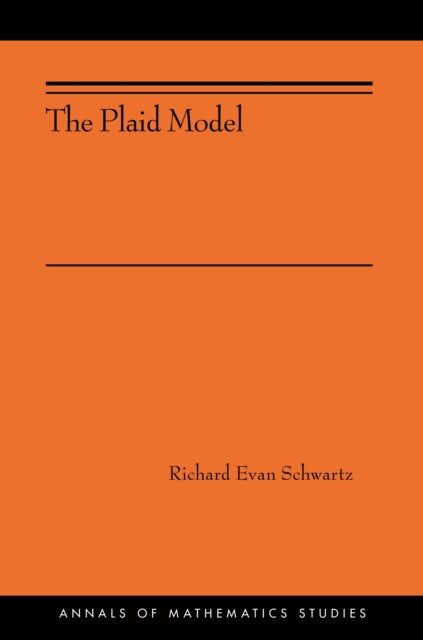Richard Evan Schwartz
Plaid Model: (AMS-198)
Plaid Model: (AMS-198)
YOU SAVE £14.88
- Condition: Brand new
- UK Delivery times: Usually arrives within 2 - 3 working days
- UK Shipping: Fee starts at £2.39. Subject to product weight & dimension
Bulk ordering. Want 15 or more copies? Get a personalised quote and bigger discounts. Learn more about bulk orders.
Couldn't load pickup availability
- More about Plaid Model: (AMS-198)
Outer billiards is a toy model for planetary motion that exhibits intricate and mysterious behavior. The Plaid Model provides a combinatorial model for orbits of outer billiards on kites, which has a self-similar structure that blends geometry and elementary number theory. The results were discovered through computer experimentation and are difficult to reach through traditional mathematics.
\n Format: Paperback / softback
\n Length: 280 pages
\n Publication date: 19 February 2019
\n Publisher: Princeton University Press
\n
Outer billiards serves as a captivating toy model for the study of planetary motion, exhibiting intricate and enigmatic behavior even in seemingly straightforward scenarios. It represents a dynamical system where a particle in a plane navigates around the exterior of a convex shape, following a scheme reminiscent of traditional billiards.
The Plaid Model, a self-contained sequel to Richard Schwartz's renowned Outer Billiards on Kites, presents a combinatorial framework for the orbits of outer billiards on kites. Schwartz establishes connections between these orbits and diverse subjects such as polytope exchange transformations, renormalization, continued fractions, corner percolation, and the Truchet tile system. The "plaid model" exhibits a self-similar structure that seamlessly blends geometry and elementary number theory.
Through extensive computer experimentation, the results of this study were unveiled, suggesting that traditional mathematics may find it challenging to reach the same conclusions. The book includes an extensive computer program that enables readers to explore the materials interactively, and each theorem is accompanied by a computer demonstration to enhance understanding.
Outer billiards serves as a captivating toy model for the study of planetary motion, exhibiting intricate and enigmatic behavior even in seemingly straightforward scenarios. It represents a dynamical system where a particle in a plane navigates around the exterior of a convex shape, following a scheme reminiscent of traditional billiards.
The Plaid Model, a self-contained sequel to Richard Schwartz's renowned Outer Billiards on Kites, presents a combinatorial framework for the orbits of outer billiards on kites. Schwartz establishes connections between these orbits and diverse subjects such as polytope exchange transformations, renormalization, continued fractions, corner percolation, and the Truchet tile system. The "plaid model" exhibits a self-similar structure that seamlessly blends geometry and elementary number theory.
Through extensive computer experimentation, the results of this study were unveiled, suggesting that traditional mathematics may find it challenging to reach the same conclusions. The book includes an extensive computer program that enables readers to explore the materials interactively, and each theorem is accompanied by a computer demonstration to enhance understanding.
Outer billiards serves as a captivating toy model for the study of planetary motion, exhibiting intricate and enigmatic behavior even in seemingly straightforward scenarios. It represents a dynamical system where a particle in a plane navigates around the exterior of a convex shape, following a scheme reminiscent of traditional billiards.
The Plaid Model, a self-contained sequel to Richard Schwartz's renowned Outer Billiards on Kites, presents a combinatorial framework for the orbits of outer billiards on kites. Schwartz establishes connections between these orbits and diverse subjects such as polytope exchange transformations, renormalization, continued fractions, corner percolation, and the Truchet tile system. The "plaid model" exhibits a self-similar structure that seamlessly blends geometry and elementary number theory.
Through extensive computer experimentation, the results of this study were unveiled, suggesting that traditional mathematics may find it challenging to reach the same conclusions. The book includes an extensive computer program that enables readers to explore the materials interactively, and each theorem is accompanied by a computer demonstration to enhance understanding.
\n Weight: 486g\n
Dimension: 158 x 234 x 19 (mm)\n
ISBN-13: 9780691181387\n \n
This item can be found in:
UK and International shipping information
UK and International shipping information
UK Delivery and returns information:
- Delivery within 2 - 3 days when ordering in the UK.
- Shipping fee for UK customers from £2.39. Fully tracked shipping service available.
- Returns policy: Return within 30 days of receipt for full refund.
International deliveries:
Shulph Ink now ships to Australia, Belgium, Canada, France, Germany, Ireland, Italy, India, Luxembourg Saudi Arabia, Singapore, Spain, Netherlands, New Zealand, United Arab Emirates, United States of America.
- Delivery times: within 5 - 10 days for international orders.
- Shipping fee: charges vary for overseas orders. Only tracked services are available for most international orders. Some countries have untracked shipping options.
- Customs charges: If ordering to addresses outside the United Kingdom, you may or may not incur additional customs and duties fees during local delivery.


